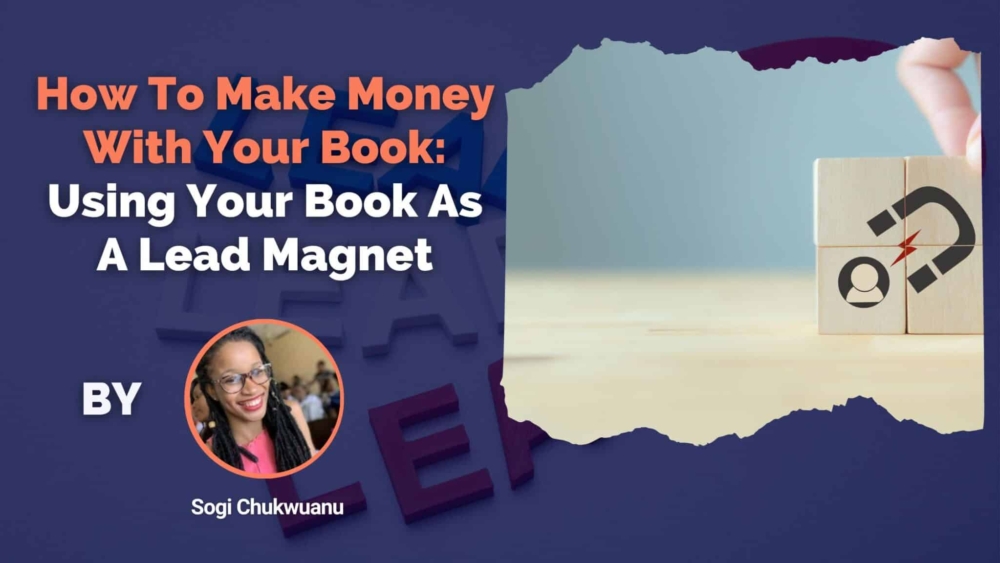By Sogi Chukwuanu
How can I make money with my book?
Fun fact: in February 2024, this phrase was googled at least a hundred times in one day.
Many business leaders turned authors know that their book can drive leads and (directly or indirectly) generate revenue for them.
The question is: how?
In this blog, we’ll break down how you can make money with your book by turning it into a lead magnet. If you’ve written a book but aren’t sure how to make it work for you, you’ll benefit from this article.
But let’s begin with the basics: what is a lead magnet?
The real definition of a lead magnet
Most sources would describe a lead magnet as a marketing tool that you offer to prospects for free in exchange for their contact information. While this definition is technically correct, it does feel a little like this:

Signing up for a lead magnet shouldn’t feel like your prospects are handing over their voice (information) to a sea witch in exchange for a pair of legs (valuable content). Instead, it should feel like they’re joining a tribe or community that will be incredibly beneficial to them in the long run.
This means they’ll be less likely to unsubscribe from your mailing list after they receive the first few emails, and they’ll engage more with your content. So, to properly frame your book as a lead magnet, you must:
- Provide immense value upfront
- Tailor your communication and content to the specific needs, interests, and challenges of your audience.
How using your book as a lead magnet can generate revenue for you
One of the benefits of using your book as a lead magnet is the potential for upsells and cross-sells.
Once someone has shown interest in your free book, you have the opportunity to introduce them to paid offerings. These can include more detailed books, courses, consulting services, or related products. The initial free book acts as an entry point to your ecosystem of products and services.
It can also drive traffic to your website, which is beneficial for search engine optimisation (SEO). More traffic and engagement on your site can improve your site’s ranking in search engine results, leading to more visibility and potential sales.
The question here is: how should you use your book as a lead magnet?
Tips for using your book as a lead magnet
1. Segment your book
You don’t necessarily have to give away the entire book as a lead magnet. You could use a chapter or a summarised version of it to entice readers.
For example, here’s author Melody Wilding offering a free chapter of her book to her audience on LinkedIn:

You want to identify the key takeaways or the most compelling pieces of information that will entice your target audience. Consider parts of your book that function well as standalone pieces but also spark curiosity about the rest of the content.
For instance, if you’ve written a how-to guide on financial planning, a chapter that introduces a powerful concept (e.g. work-optional lifestyle planning) or offers actionable steps can be a great choice.
2. Create a high-quality landing page
Your landing page should clearly communicate the value of your book and what readers will learn or gain by downloading it. Use compelling headlines, bullet points, and testimonials to highlight the benefits of the book.
You also want to ensure that the sign-up form is simple and only asks for essential information like their names and email addresses.
3. Promote your lead magnet
Utilise various platforms to promote your lead magnet. This can include your website, blog, social media channels, email signature, and even within the content of other books or publications. Paid advertising on platforms like Facebook, Google, and LinkedIn can also help reach a wider audience.
4. Nurture your leads
According to Hubspot, companies that nurture leads make 50 per cent more sales at a cost 33 per cent lower than non-nurtured leads. This means that if you’re using your book as a lead magnet, it’s important to ensure that you’re nurturing those leads every step of the way.
Provide them with valuable content, updates about your work, and offers related to your book’s topic. This helps build a relationship with your audience and can lead to future sales.
It’s worth noting that not all leads are the same – they may have needs in common (which is what led them to your book), but their specific interests and behaviours may vary.
For instance, if you’re a financial adviser, some of your leads might be people looking to make wise investment decisions, while others might be seeking will and probate advice.
Use the information you gather during the sign-up process to segment your audience into different groups based on their preferences, behaviours, and demographics. This allows you to tailor your communication and provide more relevant content.
5. Measure and adjust
Keep track of your lead magnet’s performance by monitoring sign-ups, conversion rates, and any feedback you receive. Use this data to make adjustments to your strategy, landing page, or promotion efforts as needed.
Final thoughts
Remember: the key to making sure your book works for you (whether as a lead magnet or a standalone piece) is providing readers with valuable, actionable content that they can connect with.
If you feel like your book isn’t good enough or you’re not quite sure how to make it work for you and your audience, get in touch today to see how we can help you.
P.S. We’ll soon be revealing 2024’s top AI-assisted tools for authoring a non-fiction book. Click here to join our priority list and gain early access.
